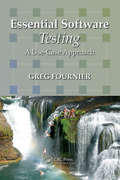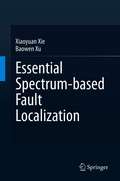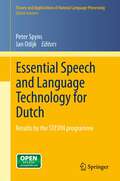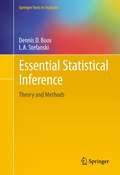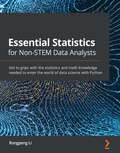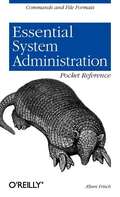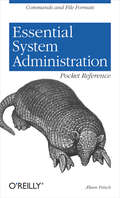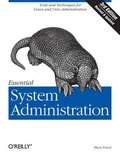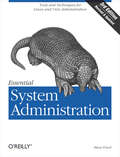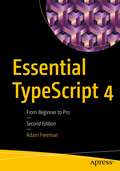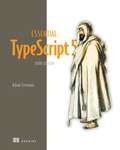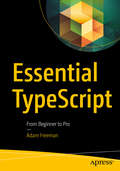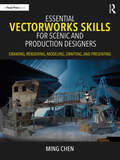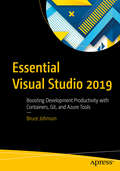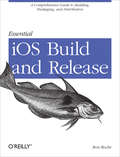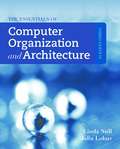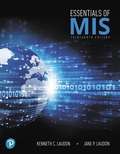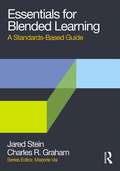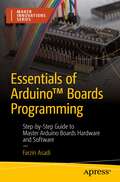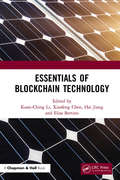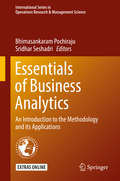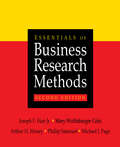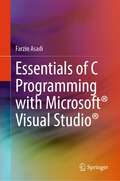- Table View
- List View
Essential Software Testing: A Use-Case Approach
by Greg FournierA Practical Guide to Software TestingMuch has been written about the difficulty of software testing. Often these laments are accompanied by cautionary words about how careful one has to be to ensure testing is done properly. However, there is a dearth of resources that give practical guidance on the nuts and bolts of testing. Essential Software Tes
Essential Spectrum-based Fault Localization
by Xiaoyuan Xie Baowen XuProgram debugging has always been a difficult and time-consuming task in the context of software development, where spectrum-based fault localization (SBFL) is one of the most widely studied families of techniques. While it’s not particularly difficult to learn about the process and empirical performance of a particular SBFL technique from the available literature, researchers and practitioners aren’t always familiar with the underlying theories. This book provides the first comprehensive guide to fundamental theories in SBFL, while also addressing some emerging challenges in this area. The theoretical framework introduced here reveals the intrinsic relations between various risk evaluation formulas, making it possible to construct a formula performance hierarchy. Further extensions of the framework provide a sufficient and necessary condition for a general maximal formula, as well as performance comparisons for hybrid SBFL methods. With regard to emerging challenges in SBFL, the book mainly covers the frequently encountered oracle problem in SBFL and introduces a metamorphic slice-based solution. In addition, it discusses the challenge of multiple-fault localization and presents cutting-edge approaches to overcoming it. SBFL is a widely studied research area with a massive amount of publications. Thus, it is essential that the software engineering community, especially those involved in program debugging, software maintenance and software quality assurance (including both newcomers and researchers who want to gain deeper insights) understand the most fundamental theories – which could also be very helpful to ensuring the healthy development of the field.
Essential Speech and Language Technology for Dutch: Results by the STEVIN-programme (Theory and Applications of Natural Language Processing #14)
by Peter Spyns Linde Van Bosch Jan OdijkThe book provides an overview of more than a decade of joint R&D efforts in the Low Countries on HLT for Dutch. It not only presents the state of the art of HLT for Dutch in the areas covered, but, even more importantly, a description of the resources (data and tools) for Dutch that have been created are now available for both academia and industry worldwide. The contributions cover many areas of human language technology (for Dutch): corpus collection (including IPR issues) and building (in particular one corpus aiming at a collection of 500M word tokens), lexicology, anaphora resolution, a semantic network, parsing technology, speech recognition, machine translation, text (summaries) generation, web mining, information extraction, and text to speech to name the most important ones. The book also shows how a medium-sized language community (spanning two territories) can create a digital language infrastructure (resources, tools, etc.) as a basis for subsequent R&D. At the same time, it bundles contributions of almost all the HLT research groups in Flanders and the Netherlands, hence offers a view of their recent research activities. Targeted readers are mainly researchers in human language technology, in particular those focusing on Dutch. It concerns researchers active in larger networks such as the CLARIN, META-NET, FLaReNet and participating in conferences such as ACL, EACL, NAACL, COLING, RANLP, CICling, LREC, CLIN and DIR ( both in the Low Countries), InterSpeech, ASRU, ICASSP, ISCA, EUSIPCO, CLEF, TREC, etc. In addition, some chapters are interesting for human language technology policy makers and even for science policy makers in general.
Essential Statistical Inference
by Dennis D. Boos L A StefanskiThis book is for students and researchers who have had a first year graduate level mathematical statistics course. It covers classical likelihood, Bayesian, and permutation inference; an introduction to basic asymptotic distribution theory; and modern topics like M-estimation, the jackknife, and the bootstrap. R code is woven throughout the text, and there are a large number of examples and problems. An important goal has been to make the topics accessible to a wide audience, with little overt reliance on measure theory. A typical semester course consists of Chapters 1-6 (likelihood-based estimation and testing, Bayesian inference, basic asymptotic results) plus selections from M-estimation and related testing and resampling methodology. Dennis Boos and Len Stefanski are professors in the Department of Statistics at North Carolina State. Their research has been eclectic, often with a robustness angle, although Stefanski is also known for research concentrated on measurement error, including a co-authored book on non-linear measurement error models. In recent years the authors have jointly worked on variable selection methods.
Essential Statistics for Non-STEM Data Analysts: Get to grips with the statistics and math knowledge needed to enter the world of data science with Python
by Rongpeng LiReinforce your understanding of data science and data analysis from a statistical perspective to extract meaningful insights from your data using Python programmingKey FeaturesWork your way through the entire data analysis pipeline with statistics concerns in mind to make reasonable decisionsUnderstand how various data science algorithms functionBuild a solid foundation in statistics for data science and machine learning using Python-based examplesBook DescriptionStatistics remain the backbone of modern analysis tasks, helping you to interpret the results produced by data science pipelines. This book is a detailed guide covering the math and various statistical methods required for undertaking data science tasks. The book starts by showing you how to preprocess data and inspect distributions and correlations from a statistical perspective. You'll then get to grips with the fundamentals of statistical analysis and apply its concepts to real-world datasets. As you advance, you'll find out how statistical concepts emerge from different stages of data science pipelines, understand the summary of datasets in the language of statistics, and use it to build a solid foundation for robust data products such as explanatory models and predictive models. Once you've uncovered the working mechanism of data science algorithms, you'll cover essential concepts for efficient data collection, cleaning, mining, visualization, and analysis. Finally, you'll implement statistical methods in key machine learning tasks such as classification, regression, tree-based methods, and ensemble learning. By the end of this Essential Statistics for Non-STEM Data Analysts book, you'll have learned how to build and present a self-contained, statistics-backed data product to meet your business goals.What you will learnFind out how to grab and load data into an analysis environmentPerform descriptive analysis to extract meaningful summaries from dataDiscover probability, parameter estimation, hypothesis tests, and experiment design best practicesGet to grips with resampling and bootstrapping in PythonDelve into statistical tests with variance analysis, time series analysis, and A/B test examplesUnderstand the statistics behind popular machine learning algorithmsAnswer questions on statistics for data scientist interviewsWho this book is forThis book is an entry-level guide for data science enthusiasts, data analysts, and anyone starting out in the field of data science and looking to learn the essential statistical concepts with the help of simple explanations and examples. If you're a developer or student with a non-mathematical background, you'll find this book useful. Working knowledge of the Python programming language is required.
Essential System Administration Pocket Reference
by 198 Leen FrischThis pocket reference brings together all the important Unix and Linux system administration information in a single compact volume. Not only are all of the important administrative commands covered, but this reference also includes the locations and formats of important configuration files (including both general system databases like the password and group files as well as the configuration files for major subsystems like DNS, DHCP and sendmail). In addition, variations in command usage and file formats a
Essential System Administration Pocket Reference
by Æleen FrischIf you're a Unix system administrator, then the information you need every day just to get your job done could fill a book--a very large book. But, practically speaking, you don't want to stop and thumb through a weighty volume each time a problem arises. Your answer is the Essential System Administration Pocket Reference , the only system administration reference that fits in your pocket. Concise and easy-to-use, this little book is the portable companion to the classic Essential System Administration by Æleen Frisch. The Essential System Administration Pocket Reference is a quick reference to all the fundamental and essential tasks required to run such divergent Unix systems as Solaris, Linux, AIX, BSD, SuSe, Red Hat, and more. Beginners and experienced administrators alike will quickly be able to apply its principles and advice to solve everyday problems. The book is divided into three parts: Commands, Syntax and Their Applications, Configuration Files and Formats, and Operating System Specific Information. The information in this book is a must-have for any administrator or user of a Unix system. O'Reilly's Pocket References have become a favorite among technology professionals everywhere. By providing a wealth of important details in a concise, well-organized format, these handy books deliver just what you need to complete the task at hand. When you've reached a sticking point and need to get to a solution quickly, the new Essential System Administration Pocket Reference is the book you'll want to have.
Essential System Administration Pocket Reference: Commands and File Formats
by Æleen FrischIf you're a Unix system administrator, then the information you need every day just to get your job done could fill a book--a very large book. But, practically speaking, you don't want to stop and thumb through a weighty volume each time a problem arises. Your answer is the Essential System Administration Pocket Reference, the only system administration reference that fits in your pocket. Concise and easy-to-use, this little book is the portable companion to the classic Essential System Administration by AEleen Frisch.The Essential System Administration Pocket Reference is a quick reference to all the fundamental and essential tasks required to run such divergent Unix systems as Solaris, Linux, AIX, BSD, SuSe, Red Hat, and more. Beginners and experienced administrators alike will quickly be able to apply its principles and advice to solve everyday problems. The book is divided into three parts: Commands, Syntax and Their Applications, Configuration Files and Formats, and Operating System Specific Information. The information in this book is a must-have for any administrator or user of a Unix system.O'Reilly's Pocket References have become a favorite among technology professionals everywhere. By providing a wealth of important details in a concise, well-organized format, these handy books deliver just what you need to complete the task at hand. When you've reached a sticking point and need to get to a solution quickly, the new Essential System Administration Pocket Reference is the book you'll want to have.
Essential System Administration, 3rd Edition
by Leen FrischWhether you use a standalone Unix system, routinely provide administrative support for a larger shared system, or just want an understanding of basic administrative functions, Essential System Administrationis for you. This comprehensive and invaluable book combines the author's years of practical experience with technical expertise to help you manage Unix systems as productively and painlessly as possible.
Essential System Administration: Tools and Techniques for Linux and Unix Administration
by Æleen FrischEssential System Administration,3rd Edition is the definitive guide for Unix system administration, covering all the fundamental and essential tasks required to run such divergent Unix systems as AIX, FreeBSD, HP-UX, Linux, Solaris, Tru64 and more. Essential System Administration provides a clear, concise, practical guide to the real-world issues that anyone responsible for a Unix system faces daily.The new edition of this indispensable reference has been fully updated for all the latest operating systems. Even more importantly, it has been extensively revised and expanded to consider the current system administrative topics that administrators need most. Essential System Administration,3rd Edition covers: DHCP, USB devices, the latest automation tools, SNMP and network management, LDAP, PAM, and recent security tools and techniques.Essential System Administration is comprehensive. But what has made this book the guide system administrators turn to over and over again is not just the sheer volume of valuable information it provides, but the clear, useful way the information is presented. It discusses the underlying higher-level concepts, but it also provides the details of the procedures needed to carry them out. It is not organized around the features of the Unix operating system, but around the various facets of a system administrator's job. It describes all the usual administrative tools that Unix provides, but it also shows how to use them intelligently and efficiently.Whether you use a standalone Unix system, routinely provide administrative support for a larger shared system, or just want an understanding of basic administrative functions, Essential System Administration is for you. This comprehensive and invaluable book combines the author's years of practical experience with technical expertise to help you manage Unix systems as productively and painlessly as possible.
Essential Tools for Water Resources Analysis, Planning, and Management (Springer Water)
by Omid Bozorg-HaddadThis book describes concepts and tools needed for water resources management, including methods for modeling, simulation, optimization, big data analysis, data mining, remote sensing, geographical information system, game theory, conflict resolution, System dynamics, agent-based models, multiobjective, multicriteria, and multiattribute decision making and risk and uncertainty analysis, for better and sustainable management of water resources and consumption, thus mitigating the present and future global water shortage crisis. It presents the applications of these tools through case studies which demonstrate its benefits of proper management of water resources systems. This book acts as a reference for students, professors, industrial practitioners, and stakeholders in the field of water resources and hydrology.
Essential TypeScript 4: From Beginner to Pro
by Adam FreemanLearn the essentials and more of TypeScript, a popular superset of the JavaScript language that adds support for static typing. TypeScript combines the typing features of C# or Java with the flexibility of JavaScript, reducing typing errors and providing an easier path to JavaScript development.Author Adam Freeman explains how to get the most from TypeScript 4 in this second edition of his best-selling book. He begins by describing the TypeScript language and the benefits it offers and then shows you how to use TypeScript in real-world scenarios, including development with the DOM API, and popular frameworks such as Angular and React. He starts from the nuts-and-bolts and builds up to the most advanced and sophisticated features.Each topic is covered clearly and concisely, and is packed with the details you need to be effective. The most important features are given a no-nonsense, in-depth treatment and chapters include common problems and teach you how to avoid them.What You Will LearnGain a solid understanding of the TypeScript language and toolsUse TypeScript for client- and server-side developmentExtend and customize TypeScriptTest your TypeScript codeApply TypeScript with the DOM API, Angular, React, and Vue.js Who This Book Is ForJavaScript developers who want to use TypeScript to create client-side or server-side applications
Essential TypeScript 5, Third Edition
by Adam FreemanNow in its third edition, this bestselling guide to TypeScript takes you through the nuts and bolts of the language. No frills, no fuss—just TypeScript essentials!TypeScript enhances JavaScript with static typing, while keeping all the JS flexibility you know and love! It&’s the perfect choice for any developer looking to improve the predictability and reliability of their code. Essential TypeScript 5, Third Edition teaches you how to get the most out of TypeScript 5 for a consistent, dependable development experience. Inside Essential TypeScript 5, Third Edition you&’ll learn how to: Configure the TypeScript development tools Use type annotations Create strongly typed functions and classes Use generic types Use type guards to determine types Create and consume type declaration files Use TypeScript to create web applications with Angular and React The book starts you off with a proper understanding of the JavaScript type system that will make using TypeScript so much easier. On that solid foundation, you&’ll build your understanding of TypeScript development, following a hands-on learning path all the way to TypeScript&’s advanced features. About the technology TypeScript is a popular superset of JavaScript that adds support for static typing. TypeScript&’s typing features, which will be instantly familiar to C# or Java programmers, help you reduce errors and improve the overall quality of your JavaScript code. About the book Essential TypeScript 5 is a fully updated third edition of the classic Adam Freeman bestseller. It provides full coverage of TypeScript 5, including new features like decorators. You&’ll begin with the hows-and-whys of TypeScript, then quickly progress to practical applications of static types. No wasted pages! Each chapter is focused on the skills you need to write awesome web apps. What's inside Configure your development tools Create strongly typed functions and classes Use generic types, type annotations, and type guards Create and consume type declaration files About the reader For JavaScript developers. No previous experience with TypeScript required. About the author Adam Freeman has held senior positions in a range of companies, most recently serving as CTO and COO of a global bank. He has written 50 programming books. The technical editor on this book is Fabio Claudio Ferracchiati. Table of Contents 1 Understanding TypeScript Part 1 2 Your first TypeScript application 3 JavaScript primer, part 1 4 JavaScript primer, part 2 5 Using the TypeScript compiler 6 Testing and debugging TypeScript Part 2 7 Understanding static types 8 Using functions 9 Using arrays, tuples, and enums 10 Working with objects 11 Working with classes and interfaces 12 Using generic types 13 Advanced generic types 14 Using decorators 15 Working with JavaScript Part 3 16 Creating a stand-alone web app, part 1 17 Creating a stand-alone web app, part 2 18 Creating an Angular app, part 1 19 Creating an Angular app, part 2 20 Creating a React app 21 Creating a React app, part 2
Essential TypeScript: From Beginner to Pro
by Adam FreemanWork with Typescript and get the most from this versatile open source language. Author Adam Freeman begins this book by describing Typescript and the benefits it offers, and goes on to show you how to use TypeScript in realistic scenarios, going in-depth to give you the knowledge you need. Starting from the nuts-and-bolts and building up to the most advanced and sophisticated features, you will learn how TypeScript builds on the JavaScript type system to create a safer and more productive development experience and understand how TypeScript can be used to create applications using popular frameworks, including Node.js, Angular, React, and Vue.js.Each topic is covered clearly and concisely and is packed with the details you need to learn to be truly effective. The most important features are given a no-nonsense in-depth treatment and chapters include common problems and details of how to avoid them.What You Will LearnGain a solid understanding of the TypeScript language and toolsUse TypeScript for client- and server-side developmentExtend and customize TypeScriptDebug and unit test your TypeScript codeWho This Book Is ForDevelopers who want to start using TypeScript, for example to create rich web applications using Angular, React, or Vue.jsAdam Freeman is an experienced IT professional who has held senior positions in a range of companies, most recently serving as chief technology officer and chief operating officer of a global bank. Now retired, he spends his time writing and long-distance running.
Essential Vectorworks Skills for Scenic and Production Designers: Drawing, Rendering, Modeling, Drafting, and Presenting
by Ming ChenEssential Vectorworks Skills for Scenic and Production Designers is an accessible textbook that covers the digital skills of 2D drawing, 3D modeling, rendering, drafting, and design presentation, providing aspiring designers with an invaluable toolkit to quickly and efficiently hone their craft.Modeled after learner-centered teaching practice and based on USITT drafting standards, this book is structured around six carefully selected core projects. It introduces key terms and commands, tools, techniques, and procedures for drawing, modeling, rendering, drafting, and design presentation with Vectorworks. Each chapter begins with key commands and a set of learning objectives that will be explored. The design exercises and projects that follow invite the reader’s active participation in the learning process. Along with step-by-step instructions, 240 illustrations (including student work samples), and three insightful interviews with professional designers, this book also contains open-ended projects that encourage the reader to explore new ways of scenographic expression and creatively apply commands and techniques to solve example design problems.This textbook is for use in scenic design, drafting, model making, and rendering courses in university theatre and media programs, and may be of interest to emerging professional scenic designers or scenographers for theatre, opera, and concert performances, production designers or art directors in film and television industries, themed exhibition designers, and theme park designers.Essential Vectorworks Skills for Scenic and Production Designers includes access to a wealth of online resources, including 15 videos with step-by-step instruction, six files of vwx or PDF formats for additional exercises and projects, and a video of student work samples.
Essential Visual Studio 2019: Boosting Development Productivity with Containers, Git, and Azure Tools
by Bruce JohnsonDiscover how Visual Studio 2019 can improve your development process. Visual Studio is an integral part of the daily life of millions of developers worldwide. Even as this rich integrated development environment approaches two decades, it has never ceased in innovating ways to make developers’ work life more productive. Essential Visual Studio 2019 offers explicit guidance for the developer who is already familiar with Visual Studio, but might feel a little lost when it comes to understanding the more recent features and advances of the IDE. Busy developers simply don’t have the time to digest and distill what the latest and greatest tools are with each version. As a result, useful process and performance features may be overlooked. This book, by simply focusing on the most recent innovations in Visual Studio and its tangential developer market, is the perfect "go to" for bridging that gap.Be ready to plunge headfirst into key features and advances that have been added, expanded, or improved, and topics such as unit testing, refactoring, Git, debugging, containers, and more. You will procure the basic concepts and value first, before diving into hands-on code that is designed to quickly get you up and running. The goal of this book is to bring the developer up to speed on Visual Studio 2019. It does not focus just on functionality added in Visual Studio 2019, but takes a deep dive into the areas where Visual Studio 2019 changed. That way, even if you’re coming from much earlier versions of Visual Studio, you can easily discern how upgrading to Visual Studio 2019 can make you more productive.What You Will Learn Know how the new features and improvements in Visual Studio 2019 can make you more productiveUnderstand the value of modifications and when they can be used to take full advantage of this powerful IDEReview changes to Visual Studio over the last two versions and see where the development process is headingDiscover the cloud-based, containerized, dev-ops-aware, and platform-flexible aspects of Visual StudioGain clarity on the areas that have the greatest impact to you personallyWho This Book Is ForDevelopers who use Visual Studio on a daily basis. Familiarity with earlier versions is helpful, as the book is not a soup-to-nuts survey of the IDE and some basic functions will not be covered.
Essential iOS Build and Release: A Comprehensive Guide to Building, Packaging, and Distribution (Oreilly And Associate Ser.)
by Ron RocheFrustrated by the requirements for testing and distributing your iOS app? You’re not alone. This concise book takes you step by step through the maze of certification and provisioning processes that have to happen before, during, and after development. You’ll learn what’s required to sign certificates, test your app on iOS devices, and release the finished product to the App Store.Whether you’re a developer looking to spend more time coding and less time figuring out how to install your application, or a release engineer responsible for producing reliable builds, this guide will help you successfully navigate the build and release processes for your iOS app.Get an overview of the iOS Dev Center, including the iOS Provisioning Portal, Member Center, and iTunes ConnectCreate your App ID, and generate signing certificates for development and distributionManage the provisioning profiles necessary to test your app on iOS devicesLearn common scenarios for iOS Simulator, Ad Hoc, and App Store distribution buildsAutomate the process to continuously build, sign, and package your app(s) for distribution
Essentials Of Computer Organization And Architecture
by Linda Null Julia LoburUpdated and revised with the latest data in the field, The Essentials of Computer Organization and Architecture, Third Edition is a comprehensive resource that addresses all of the necessary organization and architecture topics, yet is appropriate for the one-term course. This best-selling text correlates to the 2008 ACM-IEEE Computer Science Curriculum update and exposes readers to the inner workings of a modern digital computer through an integrated presentation of fundamental concepts and principles. The authors present real-world examples and focus on practical applications, thus encouraging students to develop a "big picture" understanding of how essential organization and architecture concepts are applied in the world of computing.
Essentials Of Mis, Student Value Edition
by Kenneth C. Laudon Jane LaudonEssentials of MIS is an in-depth look at how today's businesses use information technologies and systems to achieve their corporate objectives. Current real-world business cases illustrate how companies have identified, and ultimately solved, key business challenges using information systems and technologies. Through the use of Essentials of MIS, you will be able to participate in, and even lead, management discussions of information systems for a firm. <P><P> The 13th Edition consists of 12 chapters with hands-on projects that cover the most essential topics in MIS. In addition to the core text, this edition includes a Video Case Package consisting of 28 video case studies and 10 instructional videos to illustrate business uses of information systems, explain new technologies, and explore concepts. The knowledge and information in this book will be most valuable throughout your business career.
Essentials for Blended Learning: A Standards-Based Guide (Essentials of Online Learning)
by Charles R. Graham Jared SteinEssentials for Blended Learning: A Standards-Based Guide provides a practical, streamlined approach for creating effective learning experiences by blending online activities and the best of face-to-face teaching. This guide is: Easy to use: Clear, jargon-free writing; illustrations; and references to online resources help readers understand concepts. Streamlined: A simple but effective design process focuses on creating manageable activities for the right environment. Practical: Real-world examples from different subject areas help teachers understand principles in context. Contemporary: The variety of modern, connected technologies covered in the guide addresses a range of teaching challenges. Forward-Looking: The approach bridges the gap between formal classroom learning and informal lifelong learning. Standards-based: Guidelines and standards are based on current research in the field, relevant learning theories, and practitioner experiences. Effective blended learning requires significant rethinking of teaching practices and a fundamental redesign of course structure. Essentials for Blended Learning: A Standards-Based Guide simplifies these difficult challenges without neglecting important opportunities to transform teaching. This guide is suitable for teachers in any content area. Please visit www.essentialsforblended.com for additional resources.
Essentials of Arduino™ Boards Programming: Step-by-Step Guide to Master Arduino Boards Hardware and Software (Maker Innovations Series)
by Farzin AsadiLearn to use the Arduino boards to do big jobs in a simple way. This book is full of real-world examples for Arduino enthusiasts of all experience levels. All of the examples in this book use Arduino UNO, which is an excellent option for educational purposes. You'll start with an introduction to Arduino and see firsthand how its free multi-platform integrated development environment (IDE) makes coding easier. In many cases, you can edit the given codes to solve your own problems. Arduino boards use a variety of microcontrollers and each board is suitable for a specific application. The Arduino IDE is also preloaded with a broad library of codes that you can modify and practice with. So instead of coding from scratch you can adjust the codes for similar projects. More experienced users will save time by simply copying nuggets of code from the various libraries.You'll also learn about digital input/output (I/O), analog-to-digital and digital-to-analog converters, LCDs and EEPROM. The book then moves on to serial communication, mathematical functions, and pulse width modulation (PWM), all important features when encoding in telecommunications. Finally, you'll see how to control different types of motors, review interrupts, internal comparators, and timers, and read different sensors with Arduino.What You Will LearnTurn on/off a device using a relayGenerate analog/digital outputRead an analog/digital inputControl motors with a parallel virtual machine (PVM) and serial communicationDisplay text with LCDsRead sensors with Arduino and use the interruptsWrite more efficient codes with interrupts and timersWho This Book Is ForEngineering (electrical/computer/biomedical/robotic/mechatronics/aerospace) and science (math/physic/chemistry) students, makers, and hobbyists. Being familiar with a programming language (especially C) is an advantage, however, it is not necessary.
Essentials of Blockchain Technology
by Hai Jiang Elisa Bertino Kuan-Ching Li Xiaofeng ChenBlockchain technologies, as an emerging distributed architecture and computing paradigm, have accelerated the development/application of the Cloud/GPU/Edge Computing, Artificial Intelligence, cyber physical systems, social networking, crowdsourcing and crowdsensing, 5G, trust management, and finance. The popularity and rapid development of Blockchain brings many technical and regulatory challenges for research and academic communities. This book will feature contributions from experts on topics related to performance, benchmarking, durability, robustness, as well data gathering and management, algorithms, analytics techniques for transactions processing, and implementation of applications.
Essentials of Business Analytics: An Introduction to the Methodology and its Applications (International Series in Operations Research & Management Science #264)
by Bhimasankaram Pochiraju Sridhar SeshadriThis comprehensive edited volume is the first of its kind, designed to serve as a textbook for long-duration business analytics programs. It can also be used as a guide to the field by practitioners. The book has contributions from experts in top universities and industry. The editors have taken extreme care to ensure continuity across the chapters.The material is organized into three parts: A) Tools, B) Models and C) Applications. In Part A, the tools used by business analysts are described in detail. In Part B, these tools are applied to construct models used to solve business problems. Part C contains detailed applications in various functional areas of business and several case studies. Supporting material can be found in the appendices that develop the pre-requisites for the main text. Every chapter has a business orientation. Typically, each chapter begins with the description of business problems that are transformed into data questions; and methodology is developed to solve these questions. Data analysis is conducted using widely used software, the output and results are clearly explained at each stage of development. These are finally transformed into a business solution. The companion website provides examples, data sets and sample code for each chapter.
Essentials of Business Research Methods: Third Edition
by Phillip Samouel Joseph F. Hair, Jr Mary Wolfinbarger Arthur H Money Michael J PageManagers increasingly must make decisions based on almost unlimited information. How can they navigate and organize this vast amount of data? Essentials of Business Research Methods provides research techniques for people who aren't data analysts. The authors offer a straightforward, hands-on approach to the vital managerial process of gathering and using data to make clear business decisions. They include such critical topics as the increasing role of online research, ethical issues, data mining, customer relationship management, and how to conduct information-gathering activities more effectively in a rapidly changing business environment. This is the only such book that includes a chapter on qualitative data analysis, and the coverage of quantitative data analysis is more extensive and much easier to understand than in other works. The book features a realistic continuing case throughout the text that enables students to see how business research information is used in the real world. It includes applied research examples in all chapters, as well as Ethical Dilemma mini - cases, and interactive Internet applications and exercises.
Essentials of C Programming with Microsoft® Visual Studio®
by Farzin AsadiThis book provides a compact but comprehensive treatment that guides readers through the C programming language with Microsoft® Visual Studio®. The author uses his extensive classroom experience to guide readers toward deeper understanding of key concepts of the C language. Each concept and feature of the language is presented as a short lesson, illustrated by practical worked examples to aid student self study. The book will appeal to a broad range of students who are required to study the C programming language.
